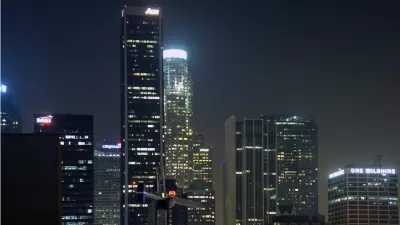“Why are lighting designers and experts nearly unified in their belief that outdoor lighting in past years has been excessive?”

Every culture in world history has associated darkness with evil, Akiva Blander points out in a lengthy piece for Metropolis Magazine on how, in the name of safety, officials in cities around the world have historically taken a more-is-more approach to outdoor lighting. But something has changed in recent years, as a "new wing" of the lighting profession is rethinking how best to light up the night.
"After years of overlighting," Blander writes, "designers, professionals, observers, and others are taking a more holistic view of outdoor illumination, examining diverse sources and gradations of light, and advocating more thoughtfully conceived lighting systems that work with, rather than in opposition to, nighttime darkness."
In addition to the relatively well-established idea that more lights have a negative effect on the health of both people and animals, there are a couple of important ideas in the article, including that more lights may not mean safer streets, and that there is a cultural, social and biological benefit to letting “night be night.”
"[I]t is critical that our contemporary nocturnal placemaking not detract from the essential qualities that differentiate it from daytime uses of public space," writes Blander, "and that our awareness of lighting’s central role allow a balanced and sensitive approach to night lighting."
FULL STORY: Can Designers Combat Light Pollution by Embracing Darkness?

Planetizen Federal Action Tracker
A weekly monitor of how Trump’s orders and actions are impacting planners and planning in America.

Chicago’s Ghost Rails
Just beneath the surface of the modern city lie the remnants of its expansive early 20th-century streetcar system.

San Antonio and Austin are Fusing Into one Massive Megaregion
The region spanning the two central Texas cities is growing fast, posing challenges for local infrastructure and water supplies.

Since Zion's Shuttles Went Electric “The Smog is Gone”
Visitors to Zion National Park can enjoy the canyon via the nation’s first fully electric park shuttle system.

Trump Distributing DOT Safety Funds at 1/10 Rate of Biden
Funds for Safe Streets and other transportation safety and equity programs are being held up by administrative reviews and conflicts with the Trump administration’s priorities.

German Cities Subsidize Taxis for Women Amid Wave of Violence
Free or low-cost taxi rides can help women navigate cities more safely, but critics say the programs don't address the root causes of violence against women.
Urban Design for Planners 1: Software Tools
This six-course series explores essential urban design concepts using open source software and equips planners with the tools they need to participate fully in the urban design process.
Planning for Universal Design
Learn the tools for implementing Universal Design in planning regulations.
planning NEXT
Appalachian Highlands Housing Partners
Mpact (founded as Rail~Volution)
City of Camden Redevelopment Agency
City of Astoria
City of Portland
City of Laramie




























